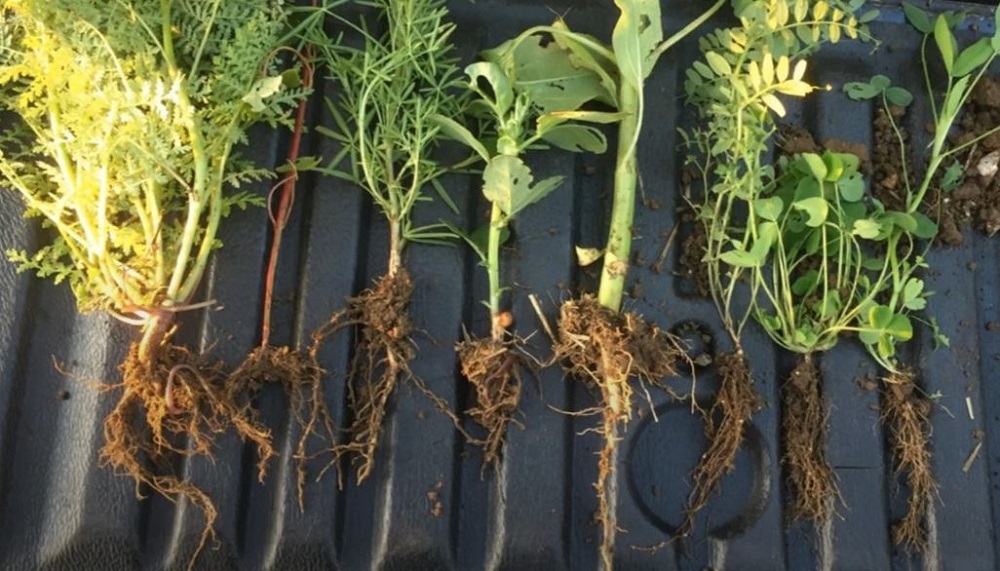Cover crops: learning from farmer experiences
Wednesday, 9 March 2022
If you want to fast-track your understanding of cover crops, then it pays to learn from others. AHDB Knowledge Exchange Manager Judith Stafford believes that listening to other farmers’ experiences could help save you time and money.
No matter the topic, hearing the experiences of other farmers is often extremely beneficial. It can help you avoid mistakes and improve the chances of succeeding more quickly. It is one of the reasons why we invest in on-farm events to promote networking opportunities.
Cover crops at Strategic Cereal Farm South
David Miller, host of our Strategic Cereal Farm in the South and manager at Wheatsheaf Farming, has over a decade of experience with cover crops – knowledge which he enthusiastically shared at an AHDB webinar held over the winter.
Visit our Strategic Cereal Farm South page
Based in Hampshire, between Basingstoke and Winchester, David manages over 700 hectares for four landowners, who are all on similar journeys: Apart from one small area, all land in David’s care has been no-tilled since 2015. Soils are reasonably light, sitting over chalk, but suffer with a clay cap and a lot of flint.
Like many growers, David has moved beyond the question of whether he should use cover crops. He now wants to know which cover crop species are best for his land.
Assessment of benefits
Cover crops are associated with numerous benefits, including:
- Enhanced nutrient capture
- Improved soil aggregation
- Increased soil friability
- Better water infiltration
- A food source for soil biology
One of David’s early lessons was patience – it takes time to figure out what works best, based on observations and measurements.
An assessment of tissue nutrients, in cover crop mixes across various fields, found that they had captured high quantities of nutrients – around 130 kg N/ha, 170 kg K/ha and 20 kg P/ha in a single season. Although David thought the results were initially good, it didn’t tell him when nutrients would become available to subsequent crops. As a result, he now focuses more on soil nutrients and soil health.
David uses worm counts as an indicator of soil health. In one trial, the number of worms per shovel of soil increased with the diversity of the cover crop mix:
- The plot with no cover crop (stubble) averaged eight worms
- The two plots with a single cover crop species (radish or mustard) averaged 10 worms
- The plot with multiple cover crop species averaged 17 worms
An analysis of some worm casts found that they would be a good medium to grow crops in. The worm-cast results are shown below, with the field averages or typical ranges indicated in brackets.
- Organic matter content 7% (4–5%)
- Phosphate nutrient index 4 (3)
- Potash nutrient index 4 (3)
- Magnesium nutrient index 2 (1)
Leaching risks
South East Water has worked with David on trials to reduce nitrogen leaching. The company prefers oil radish as a cover crop, as it is one of the best species to reduce water risks. But as a brassica species, it is not ideal because it encourages slugs and can increase disease risks to oilseed rape crops. The trials mixed oil radish with other cover crops to identify a species blend that optimised the benefit to crop productivity and the environment. Compared to a fallow-field control, all cover crop mixes offered an almost ten-fold decrease in nitrogen leaching. Typically, the broader species mix performed better.
David’s winning mixes
After years of experience, David has settled on a cover crop system that works for his land. He uses two cover crop mixes – an early- and a late-sown mix. Phacelia, sunflowers, buckwheat, lupins, vetch and beans feature in both. The early mix also contains berseem clover and crimson clover. As clovers do not grow well when sown late, these are replaced by Gold of Pleasure in the late-sown mix. He grows the lupins, vetch and beans, and buys in the remaining seed at a cost of £25/ha.
When it comes to destroying cover crops, David takes advantage of the species’ biology and weather. For example, after the first frost, the buckwheat dies. After a few more frosts, the lupins and sunflowers die. When temperatures drop to -3°, his team rolls the cover crops to help take out most of the remaining biomass. However, glyphosate is still needed to finish the job. It’s the one piece of the puzzle he’s not managed to solve, yet.
 AHDB
AHDB

